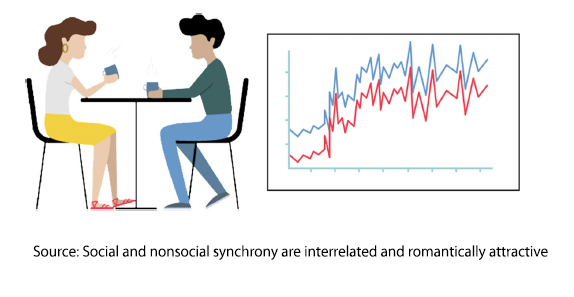
Humans, as with all biological beings, have rhythms, for example, an internal circadian rhythm of day and night that, when perturbed by multi-hour shifts from flying, results in jetlag. As social creatures, we often synchronize with one another in watching a movie, dancing in a group, or in the way couples, over time, begin to sound like one another. The psychological term for this pairing up is entrainment, adjusting one’s behavior to that of another.
Mirror neurons, neurons within our brain that fire when we do an activity and see someone else doing the same action, have been offered as an underlying physiological phenomenon to explain the “monkey see, monkey do” of entrainment. But that explanation suffers from a which came first dilemma, the neurons or the modeling of behavior. A new study seeks to link a different form of synchronization to our social behavior.
The Radio City Rockettes, Dallas Cheerleaders, Ginger Rodgers and Fred Astaire all evidenced sensorimotor synchronization. Phenotypically, we can show synchronous and non-synchronous behavior by how two individuals mimic one's words, expressions, and behaviors. We can make relatively objective measures of our ability to synchronize our body with sound by tapping our fingers with a varying metronome beat. Perfectly synchronous behavior means perfect alignment between the auditory beats and the participant’s taps, whereas more significant gaps represent poorer synchrony. An Individual Sensorimotor Synchrony Score of 0 represents complete sensorimotor synchrony. The score becomes increasingly negative as off-beat gaps develop, representing poorer synchrony.
The tell-tale heart
Research has shown that the degree to which two individuals synchronize physiologically predicts romantic and sexual attraction, at least in the context of speed-dates. [1] In this study, the researchers asked if synchrony played a role in “eliciting attention” and whether individual differences in the ability to synchronize “determined attractiveness.”
To determine attractiveness, the researchers used a subjective measure of how attractive individuals seemed on a five-point scale. They also employed a standard objective measure of arousal of the sympathetic nervous system and our attention, specifically increases in sweating measured by skin conductance.
Is Synchronicity Linked to Attractiveness?
 Yes.
Yes.
In the first study, 144 online participants aged 18-30 were randomly assigned to watch either a high or low-synchrony interaction between an actor and an actress. The short videos had been designed so that the high-synchrony film's actors were more physiologically attuned as measured by rising skin conductance; in the low-synchrony video, the actors acted independently. The results showed that high synchrony interactions significantly increased attraction scores, both for individual attractiveness and perceived mutual attraction, compared to low synchrony interactions.
In a speed-dating experiment, 48 participants, aged 19-28, each engaged in four speed-dates with different partners in a “homey” round-robin setup. The participants' social synchrony levels were measured by their average electrodermal synchrony with various partners during the speed-dates. Their nonsocial synchrony was assessed through that finger-tapping task. Romantic attractiveness was determined by averaging the attractiveness scores given by each participant's partners before and after the “date.”
The research demonstrated that physiologic scores for synchrony in the social situation of a speed date “significantly correlated” with an individual’s finger-tapping ability in a nonsocial setting.
“some individuals tend to have increased synchrony scores regardless of the task or the partner, to which we refer as Super Synchronizers.”
There is a bit of a chicken-egg problem, which comes first: synchronization or attraction. In comparing the ratings of attractiveness just as the date was beginning with the physiologic synchrony of skin conductance throughout the date, they found that for men and women, there was
“no credible evidence that initial interest determines the level of synchrony.”
In further correlations, the researchers demonstrated “the individual propensity to physiologically synchronize with partners while dating” and “individuals with an improved ability of sensorimotor synchrony are rated as more attractive.”
The conclusion:
“…the capacity to synchronize is individually associated in social and nonsocial tasks and predicts the participants’ attractiveness. Some individuals are Super Synchronizers, i.e., demonstrate increased synchrony regardless of the task or the partner, and those individuals are considered more romantically attractive. The association between electrodermal synchrony and sensorimotor synchrony suggests that social synchrony is rooted in domain-general sensorimotor skills, potentially because both require behavioral adjustment to dynamic sensory input, whether social or nonsocial.”
Adaptability and synchronization with our surroundings can be crucial survival traits in a world of constant change. This study suggests that the ability to synchronize, whether socially or nonsocially, may enhance our attractiveness, hinting at a deeper, possibly genetic, underpinning to this skill. However, it's essential to remember that correlation does not equal causation, and the stability of this effect over time remains uncertain. As we ponder the implications of these findings, it's clear that our cultural upbringing and genetic makeup likely play roles in our ability to sync with others. Of course, you already knew that.
Before jumping to any conclusions, we must remember that correlation is not causation and that in this study specifically, synchrony was tested over a very short period, and as the researchers point out, “we cannot yet determine its stability across time.”
[1] As described in Wikipedia, “Participants are rotated to meet each other over a series of short "dates" typically lasting from three to eight minutes depending on the organization running the event. At the end of each interval a signal (e.g., a ringing bell, glass clinks or a whistle blow) is given to alert participants to move on to the next date.” Speed dates are said to have about a 25% “hit” rate, as compared to online data apps at 1%.
Source: Social and nonsocial synchrony are interrelated and romantically attractive Communications Psychology DOI: 10.1038/s44271-024-00109-1



